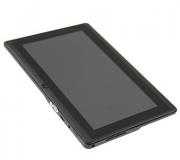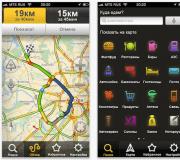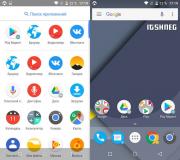Is it possible to clean the USB flash drive from viruses. Recovering media with third-party utilities
The most popular threats to flash drives are Trojans that are spread using Autorun ( automatic start). It is transferred to the USB flash drive from the computer as soon as the media is inserted and hides your folders and files. Turns them into shortcuts and thereby blocks access.
It is problematic for an ordinary user to cope with it, especially if deletion is required without data loss.
Usually such viruses are harmless on their own. They just hide files and spread to other media.
Almost any antivirus program can remove a virus from a flash drive, and infection is most likely due to its absence. This also applies to the memory card.
Here are some of the signs that your device is infected:
- Labels instead of folders.
- Loss of information.
- Unable to open USB flash drive ( but most likely another reason).
- Unknown files with exe extension.
- Autorun.
- Hidden folder RECYCLER.
Remember that these problems can occur not only if the virus is on a USB flash drive, but also on a computer or other device. Other, unpleasant things can happen in the same way. In this tutorial I will show you 2 ways to remove this virus, but of course the fastest and easiest way is. Only suitable if you do not have valuable information on it.
Manual removal method
The virus is disguised as a system file ( hidden by default) and therefore must be turned on and then switched to the USB flash drive. Here you need to delete RECYCLER, autorun and exe file. Their names may differ.
Usually this is enough, but the virus can reappear if it is additionally located in a different location. If the situation repeats, go to the next method.
Removal by antivirus
It is worth checking your computer and USB flash drive with any free or shareware antivirus. For example, try downloading NOD32 ( 30 days free). After the trial period, you can continue to use it, but without updates. I myself actively use it.
Conduct a detailed scan of your computer. All viruses will be automatically removed when found. After completion, you can view the report.

Problems after removing the virus
Most likely, the virus will hide all data. Instead, there will be shortcuts when opening which an error will appear. After all, they pointed to a virus that had already been removed. You can safely remove them.
We need to make the files visible. Using them on other devices will be inconvenient, as you will have to turn on the display of hidden folders all the time, and sometimes even this will not work.
To fix this - go to the properties of the folder and uncheck the "hidden" attribute as in the image below ( showing hidden folders must be enabled).

If the attribute is not available ( highlighted in gray), then download the executable .bat file, which will automatically fix everything.
Move it to the USB stick and run ( as administrator). Specify the letter of the carrier and press the Enter key. The letter can be viewed by going to the explorer My computer.


If this does not help, use the free USB Hidden Recovery program. Download it from the official site and install. Run and scan your flash drive, and then run recovery.

If the virus constantly appears, then it is on the computer ( or other device) and constantly infects the USB flash drive after it is deleted. Look for it with your antivirus.
This information should be sufficient to solve the problem. If something does not work out - I will be glad to answer in the comments.
How did you get rid of the virus on the USB stick?
Poll Options are limited because JavaScript is disabled in your browser.
It's no secret that a flash drive is one of the most common ways to infect your personal computer with a virus, because often for work or other issues, we insert it into different computers where we cannot guarantee that they are not infected.
If your USB flash drive has caught a virus, then in almost 95% of cases it infects the computer through autorun after you inserted the USB flash drive to yourself, in order to avoid this, you should pause such actions. Now there are a lot of programs that block startup from a flash drive (USB Guard, USB Disk Security), but the best option is to disable startup in the operating system.
To do this, go to the "Start" menu, select "Control Panel", then select "Devices and Sound" and then click on "Startup". The next step is to uncheck "Use startup for all media and devices" and then click "Save" for the changes to take effect. Now, if a virus has entered your USB flash drive, it will not automatically download to your computer.

We have protected ourselves from downloading viruses to your computer, but this is only half the battle. After using a flash drive on a potentially dangerous computer, you should always check it for viruses before working on your computer, so as not to start the virus yourself by mistake.
This is where antivirus software comes in handy. After connecting the flash drive, you should immediately check it for viruses and if any are found, you should immediately remove them, disconnect the flash drive, reconnect and check again. Here I will immediately note that you should not save on anti-virus protection and you should always use paid anti-virus programs that work with up-to-date databases.

If you do not have funds for a good antivirus, then you should check the flash drive for suspicious and hidden files. It is very easy to do this, for this we go to our flash drive, click in the top menu "View" and check the box opposite "Hidden items".

If new unknown to you have appeared next to your files, most likely these may be virus programs, and if your antivirus did not react to them in any way, then it is better to delete them. After deleting, be sure to disconnect the USB flash drive and reconnect it, repeat the verification procedure, if the files appear again, then you will have to format the USB flash drive.
These methods will usually not protect your personal computer 100%, but they are quite effective in fighting malware. It should be remembered that a flash drive is a potential target for intruders, and if it contains files that are important to you, it is better to keep a copy of them in a safe place.
The above methods are completely free and are designed so that the user understands what information is available on his flash drive.
Lim Flash Security - recovers hidden files on flash drives
The program is able to restore the operability of all usb drives infected with a virus that creates malicious shortcuts in place of programs, and makes the files themselves hidden. Free software that allows you to recover hidden files on USB drives and clean them from viruses.
Panda USB Vaccine - antivirus for a flash drive
With the help of the program, you get a double level of proactive protection against infection via usb flash drives. Panda USB Vaccine disables autorun both on the computer and on USB drives and other external devices (external hdd, players and phones).
USB Ports Disabler - disable / enable usb ports on the computer
The program prevents Windows from detecting and identifying USB devices. Allows you to quickly disable and enable USB ports without interfering with the operation of USB keyboards and mice. By disabling usb ports, you will at least be protected from viruses infecting your computer from portable devices, as well as prevent theft of personal information.
Ninja Pendisk - protecting your computer from infection via USB
Ninja Pendisk is a popular and free solution designed to protect computers from viruses transmitted via USB drives. If malicious files are found on removable drives, they will be deleted.
Ntfs Drive protection - how to prevent writing to a USB flash drive
The program will help you protect your removable drives, and even when your USB flash drive is inserted into a computer with viruses, they will not be able to log onto it and create an autorun.inf autorun file.
USB Hidden Recover - to recover hidden files and folders
If your files disappeared due to viruses, you can try to restore them using the free USB Hidden Recovery utility. It will help after viruses that hide data on flash drives, they try to change the attributes of files and folders so that they cannot always be unlocked in a standard way.
USB Disk Security - The Enemy Will Not Pass!
Protecting your computer from possible penetration of the latest viruses, "worms" and other harmful software via USB drives. The principle of the program is that it automatically disables the autorun of all removable media, passing them through itself.
Antirun - protection against infection through a USB flash drive
Convenient antivirus solution to protect your system from infection threats from USB drives. Features: controls the connection of USB devices, allows you to safely open or remove the device, protect the flash drive from viruses, completely disables autorun.
USB Hidden Folder Fix - recover hidden folders after a virus
The utility allows you to return hidden folders on a USB drive after being exposed to viruses. There are viruses that infect flash drives and external hard drives with malicious code, and change the attributes of folders and their attachments, after which they become hidden.
USB Port Locked - block USB ports
The program helps to completely close access to the computer via usb ports. The program only blocks flash drives and external USB drives, USB mice and keyboards continue to work as expected.
Dr.Web LiveDisk - anti-virus bootable USB flash drive
Creating a bootable disk Dr.Web LiveDisk is an anti-virus disk that will help to remove and neutralize viruses on a non-working system, and with its help you can transfer important information from an infected computer to another PC or to a flash drive.
LimFlashFix - display hidden folders on a USB flash drive
LimFlashFix is a free utility for curing flash drives if a virus has hidden files and folders on them. If your flash drive is empty, but you are sure that it contains files
USB Protection & Recovery - protecting your computer from viruses on a flash drive
USB Protection & Recovery is a freeware program for protecting your computer from viruses that can get on it via USB drives. Using the utility, you can recover files hidden by viruses on a USB flash drive. Program
USB Flash Security - How to Protect Data on a USB Flash Drive
It's a shame when a flash drive is lost, and it is doubly offensive when it contains any important data (secret documents, photos or videos). And whoever finds your flash drive can easily read these
Anvide Flash Lock - protect a USB flash drive from writing
Anvide Flash Lock is a tiny utility with which you can easily prevent writing to a flash drive or portable hard drive. This feature will protect your drive from viruses that can "climb" on it
USB control. USB Tool is a small program that can protect your computer from infected flash drives, as well as protect the USB flash drive from infection. The main purpose of the program is to prevent infection of the operating system and, as a result,
Sharp Eye is a small free utility (antivirus) designed to find and isolate viruses that spread through flash drives using autorun files (Autorun.inf).
USBDummyProtect - protect your flash drive from viruses
We already know how to protect your computer from an infected flash drive; there is an excellent program called Antirun. What and how to do when the flash drive is already infected and the files on it are hidden, we too
Bitdefender USB Immunizer - protector against infection through a USB flash drive
Check and delete suspicious "autorun.inf" files automatically! Autorun Eater was developed in response to the increase in malicious malware spread by "autorun.inf", be it flash drives, removable hard drives
Windows 7 Autorun Disabler - disable autorun mounted devices
The free Windows 7 Autorun Disabler program allows you to disable autorun in windows 7. Windows 7 Autorun Disabler is a portable program, to work it is necessary that the user using it has the appropriate rights to enable
Flash Defender - protecting removable media
Flash Defender - has high functionality, you can create your own autorun.inf which cannot be removed by standard means, in addition, there is a possibility to install a whole series of folders such as autorun.ini, desktop.ini, folder.tmp,
Nowadays, there are various devices for storing text and other files. For example, a USB stick is a removable type that is often used by people. Flash drives are often used because they are convenient and compact. But, unfortunately, when saving files on them, there is always a danger of "picking up" a malicious program, so everyone should know how to clean a USB flash drive from viruses. Moreover, this process is very simple.
How to clean a USB flash drive from viruses?
First, let's discuss what is needed for this process. You will need to find it with antivirus protection installed on it. Be sure to make sure that the protection program is licensed and that it has not reached the end of its service life. This is all you need to have to eliminate virus programs on a removable USB storage device.
If the anti-virus software has not been updated for a long time, then it may not recognize the virus. Therefore, look at the date of the changes made. Update the program if necessary. This should be done before you are going to clean up a virus-infected USB flash drive.
Now we connect the removable USB drive to the computer. It is worth noting that, depending on the antivirus program, the device security check can start either on its own or forcibly. So wait a few minutes. If the computer screen does not display a plate informing about the start of the test, then some more actions will need to be taken before cleaning the USB flash drive.
So, the program didn't start on its own. Open "My Computer", find the USB stick icon and right-click. From the list that appears, select "Check selected files with ..." and click on the name of the anti-virus software available on your laptop or computer.
Everything, now you just have to wait until  the security software will not find malware.
the security software will not find malware.
How to completely clean a USB flash drive from viruses?
So, if malware is found, you will see an information sign on the screen. The antivirus program will prompt you to "disinfect" or "remove". Press either one or the other button. Both methods are good enough and are used depending on the type of virus and the capabilities of the security software.
Remember that malware can infect any device. Be sure to clean your flash drives at least once a month.
From time to time, it becomes necessary to remove the virus from the phone's flash drive.
A very simple situation arises - the phone starts to glitch, constantly freezes, some data may disappear from it and other cataclysms may occur. The reason for this is a virus.
The employees of the service center can tell you about this, or you yourself determine it. It is very simple to do this - the phone freezes when working with a USB flash drive and data disappears from it. In general, it will be clearly seen that the problem is precisely in the removable storage medium.
There are 3 really working ways to solve this problem. We'll go over all of them step by step.
1. Antivirus for phones
There are quite a few good antivirus programs available that work on smartphones and tablets.
A prominent representative is Kaspersky Internet Security, which can be downloaded from Google Play and the Apple Store. We will consider its operation on the example of an Android OS device.
Step-by-step instructions for using this antivirus program are as follows:
- First, you need to download and install Kaspersky Internet Security. To do this, go to the Google Play page and follow all the above operations. Nothing fancy here, and the apps are installed just like everyone else.
- Then click on the additional functions disclosure icon. Initially, it looks like a circle with an up arrow. After clicking, a down arrow appears. These very additional functions will appear. From the entire list we need "Check". Therefore, just click on the magnifying glass icon with this inscription.

- In the next window, you just need to click on the inscription "Check folder". This will give us the opportunity to check the memory card and all the folders on it.

- Now, in fact, a window will be displayed with options for checking the folder in the device's memory or on the built-in card. We need a second option. Therefore, at this stage, you should click on the magnifying glass next to the inscription "Built-in memory card".

That’s all. If any viruses are found on the memory card, you will be prompted to remove them or move the infected files to quarantine.
Everything happens in the same way as when working with the version in Kaspersky Internet Security for personal computers.
Prompt: If no viruses were found on the memory card, perform a full scan of the entire device. This means that the problem is not with the built-in card.
2. Computer help
The second method is painfully simple and banal, but effective. Moreover, in most cases it is he who helps.
Simply put, in this case, you need to remove the memory card from the phone and insert it into the computer. Next, you will need to take one of the good antivirus programs and use it to check the USB flash drive.
Just take and insert a USB flash drive from a phone into a computer will not work - no PC or laptop has exactly the same connector.
Two devices can come to the rescue: an adapter and a card reader. The first usually comes with a microSD card. The second will have to be purchased additionally. Both devices are shown in Figure # 4 - an adapter on the left, and a card reader on the right.

Actually, the card from the phone is inserted into one of these devices, and then into the computer. The card reader works with a USB port. This is exactly what every computer has.
After you have inserted your USB flash drive from your phone into a PC or laptop in this way, it will define it as a regular memory card. After that, you need to run the antivirus and select it to check it.
For example, in Kaspersky Free you need to do the following:
- In the main window of the program, click the "Check" item. We get to the scan menu of this antivirus program.

- In the menu on the left, we see all possible verification options. We select "Check external devices". A large area appears on the right, where you can choose which device we will check. If we connected only a USB flash drive, there will be only one device. It remains to click the "Start scan" button next to it and wait for the end of this process.

- After that, as usual, when a virus is detected, several options for solving the problem will be offered. Or maybe he will be only one. In any case, you will delete an infected file or virus from your phone's flash drive, and this is the most important thing.
In addition to full-fledged anti-virus programs, you can also use small utilities to remove viruses.
Here is a list of good similar programs:
- Dr.Web CureIt;
- Kaspersky Virus Removal Tool;
- AdwCleaner;
- Anti-Malware;
- Spybot Search & Destroy;
- HitmanPro.
3. Formatting the flash drive
If the above methods do not help, there is only one thing left - to format the removable media. Then all settings and files on it will be deleted along with the virus.
Therefore, before performing this procedure, copy all the necessary files to your computer. To do this, use the aforementioned card reader or adapter.
Advice: After copying files from the flash drive, check the folder where you copied them with your antivirus. Perhaps the virus will be transferred to the computer, but it will be much easier to detect and remove it there.
- Go to "This Computer". Find us your removable storage.
- Right-click on it. In the drop-down list, select the item "Format ...".

- Uncheck the box "Fast ..." if it is there. Click the Get Started button.

- Then just wait for the operating system to do its job.
When formatting is complete, the removable media will be completely clean and free of viruses.



